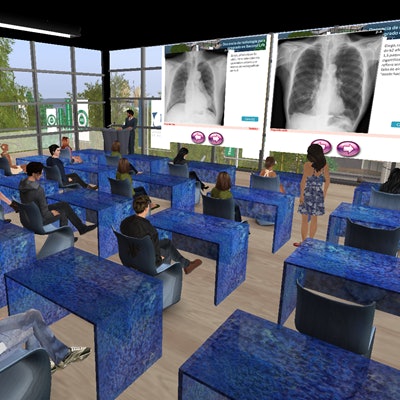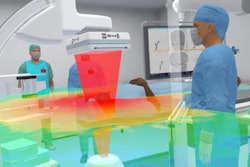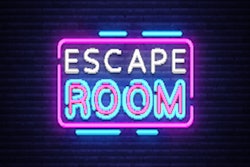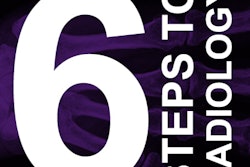
How can the immersive, simulated environment of a virtual world benefit radiology education? By offering a way for students to engage in collaborative learning and training online with minimal use of resources, found researchers from Spain in a study published online March 26 in Academic Radiology.
The group from the University of Málaga designed a virtual classroom that offered an introductory course on radiology to medical students in an online, simulated setting. In addition to attending real-time lectures and workshops, medical students of all years participating in the program were able to interact with one another and professors through an online chat.
Overall, students who completed the course rated the content and environment highly, and they claimed that it benefited their medical education, senior author Dr. Francisco Sendra-Portero, PhD, and colleagues wrote.
"Online learning of radiology within [a virtual world] is feasible and well-received by medical students," they wrote. "It is a tool that allows educational activities to be designed involving users from different geographical locations, consequently eliminating the need to travel and making a more effective use of educational resources."
 All images courtesy of Dr. Francisco Sendra-Portero, PhD.
All images courtesy of Dr. Francisco Sendra-Portero, PhD.Gamification of radiology
A growing number of Web-based and virtual reality platforms are emerging as training and educational tools in the field of radiology, such as the RadIQ virtual workstation out of Massachusetts General Hospital (MGH) and the Virtual Medical Coaching software for radiologic technologists.
Looking to build upon these newer methods of radiology education, Sendra-Portero and colleagues turned to a game-like 3D simulated space and online community known as Second Life by Linden Lab. After opening a free account, users can download viewing software to explore this virtual world as an avatar and interact with other people right from their computer.
"Virtual worlds have a remarkable potential to be used for effective teaching and learning, providing the possibility to create immersive, realistic, and engaging online events that can provide high-quality medical education to health-related users in remote locations," they wrote.
The investigators acquired and developed their own medical education campus within the Second Life universe that included an exhibit hall with instructive panels, a room holding the virtual university's radiology curriculum, and two classrooms for lectures and radiology workshops.
To test the viability of their virtual radiology education program, they invited medical students at their institution to take part in a month-long course comprising four two-hour virtual lectures and four x-ray reading and interpretation tasks that each lasted approximately three hours.
Out of the 46 students who enrolled, 20 were first-, second-, or third-year students, whom the researchers assigned to a basic radiology track in the virtual world. The remaining 26 were fourth-, fifth-, or sixth-year students who had to examine case-based clinical radiology tasks. (The medical education model in Spain consists of a six-year, combined undergraduate and medical degree.)
"The use of online resources to deliver radiology education to medical students represents an exciting alternative and an effective method for improving radiological knowledge and skills," they wrote.
'Promising expectations'
The 42 medical students who filled out an evaluation questionnaire after completing the course agreed that learning about radiology through the virtual world was "interesting," "attractive," and "appropriate," and that the virtual classroom was an "effective learning environment." They also gave the organization of the course, its educational content, and its benefit to their medical education an average score of more than nine on a 10-point scale.
The authors noted several key advantages to learning within the virtual world:
- Seamless contact via voice- and type-chat: The students were able to communicate with each other and educators on a regular basis and from remote locations.
- Increased collaboration: "The students felt comfortable, forthcoming, involved, and present in the Second Life meetings, which may have partially been due to the 'protection' effect that comes with the avatar anonymity, promoting both disclosure and sharing," the authors wrote. This virtual model can serve as a "collaborative environment where remote users can meet to discuss and make decisions to solve clinical problems."
- High-quality visualization: The contrast and detail of the medical images were excellent in the virtual world, which is ideal for radiology education.
These features point to the possibility of using virtual classrooms not only to increase the accessibility of radiology education for medical students but also to improve training for radiologists and enhance their collaboration with other medical specialties.
"Second Life has a major advantage for e-learning, since it is free for users and attractive to many students," they wrote. "The potential of using Second Life for radiology education can be extended to residents and continuing medical education courses, including promising expectations regarding collaborative learning and gamification."
A small percentage of participants reported connection failures and technical complications with the virtual world, but the authors believe that these issues will diminish as computer processing capabilities and internet connectivity continue to advance.
For future courses in the virtual radiology classroom, the group plans to include cases involving imaging modalities other than x-ray, such as CT, MRI, and ultrasound; examinations of virtual patients; and a stronger integration of radiology and anatomy -- all geared toward improving radiological interpretation.



















